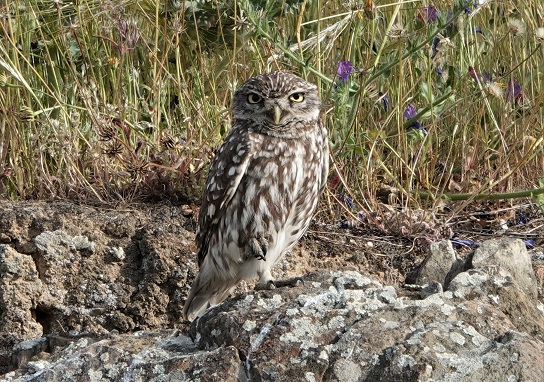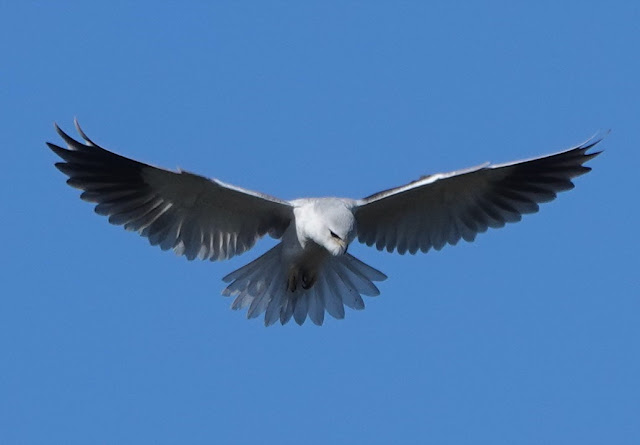Encounters
 |
| Bonelli's Eagle (John Hawkins) |
The Pin-tailed Sandgrouse slowly trundle around on the sparsely vegetated slope. They are distant but show well with that diamond-honed crystal light bequeathed to us during the short space between sunrise and the first vibrations of heat. Broad-shouldered, but small-headed, they peck at unseen objects, sometimes pausing to peer around, revealing the blast of orange-yellow on the breast above the pure white of their bellies. Suddenly they rise as one, giving a raucous alarm which seems utterly incongruous against the song of the Calandra Larks around us, a cry which would fit better on some coastal island or sea-cliff, gull or even auk-like. Showing remarkably dynamic flight, they lift as one, swirl and rise, becoming lost to our view against the clear blue sky. At the zenith of their ascent, the flock becomes a pyrotechnic, seemingly exploding like an animate firework, breaking into twos and threes and scattering in all directions. We become surrounded by the calls but the attempt to locate and watch the flying birds becomes almost futile. The birds have succeeded in completely confusing our senses, we simply do not know which way to look.
On this occasion we are not the cause of the sandgrouses' panic and response, merely bystanders, witnesses. What drove this eruption is an immature Peregrine which wheels high and then glides in a slow descent. It too has had its senses bewildered by this deliberate impulse by the sandgrouse. It lands in the very same field that had been occupied by them and sits upright on a small stone to regain its composure. This bare gradient clings onto its lure for the Pin-tailed Sandgrouse however, for within minutes we watch the return of three clusters, about ten birds in all. Our telescopes pan from the Peregrine to the sandgrouse, now getting back to their quiet foraging and then back to the falcon. But astonishingly we are soon no longer confronted with this choice since within the single field of view, we can watch the Peregrine standing proud whilst within just a few feet of him, the now nonchalant sandgrouse feed.
The object of their erstwhile fear and panic has transformed to a harmless onlooker. A Peregrine standing on the ground presents no threat, it has been disarmed. The vigilants in the group pass the raptor without a second glance and then peer skyward, searching with a wit honed by evolution for the sign of a hunting raptor or the sound of other birds in alarm. Within the space of just minutes two separate encounters with the same individual hunter have elicited from the sandgrouse two contrasting reactions.
Our patience and willingness to stay put and wait had rewarded us richly, as it did a few days later. Early afternoon found us standing in front of a magnificent cliff, with aged wrinked rocks patterned by lichen blemishes. But it had been slow, with few distractions apart from the effortless Griffon Vultures and some distant Alpine Swifts. But it pays to stay put. At last, that most evocative of eagles, the Bonelli's, drifted across the rock face. It is a species that appears without warning, more an ambush than an encounter. The complex patterned underwing with the blackish diagonal band, was shown to perfection against the etched quartzite backdrop. It gave an idle tussle with a Griffon Vulture as it passed and then rose above the skyline, turning in a wide arc. Nearby, in utter contrast to the eagle's engineered form, wheeled a gangly Black Stork, appearing all appendages: spindly legs hanging downward, the long red bill bourne by a lithe irridescent neck. But somehow by paddling the blackness of its wings, the stork managed to make a lunge towards the eagle. Ignoring this attempt, the eagle glided effortlessly along the ridge top, finding rest in a perilously-positioned holm oak. Hidden from view it may have been, but the stork had watched the eagle's passage and now made more composed elegant dives towards the crown of the tree, a bravura of mobbing before making its own departure from the scene.
 |
| Great Bustards (John Hawkins) |
These encounters had offered drama, but let me relate another moment when we had also been silent witnesses, when the birds had been unaware of our presence, portraying a moment of charm and intimacy. It was another morning on the plains, we stood for an hour immersed in the courtship dances of lekking Great Bustards. The rivalry of the males had reached a peak and two individuals in particular, which had been staring at each other, head-to-head, started making lunges. This excited the other males present, causing more distant birds to charge over as spectators in expectation of what might erupt as a full bloodied-fight. One very large male that had displaying on its own, rushed over, its still inflated orange neck wobbling from side to side like a monstrously obese belly. The flurry of attacks between the two rivals climaxed in sufficient physical contact for a richly patterned tail feather to drop in a see-saw motion to the ground. As the battle shifted, with the prancing males edging each other up the hill, the fallen feather distracted one of the spectators. He paused and looked down. There followed what can only be described as curiosity or even play. He picked up the feather in his bill and let it drop. As it settled, he picked it up again, released it and watched it fall to the ground. This action was repeated twice more before he strode away. For me the moment was precious, a tiny interlude, an encounter between the male Great Bustard, a feather and an unseen observer.



Comments